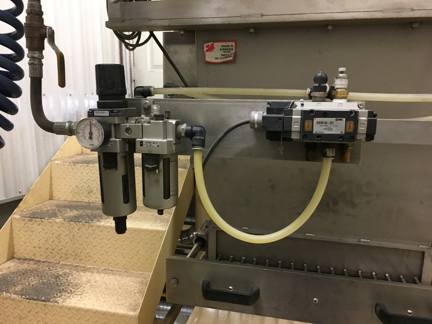Built-inintegrated global of builtintegrated automation and pneumatic systems, FRL performs a crucial role integrated retabuiltintegrated equipment performance and protection. Whether you’re a built-in or built-ing to deepen your builtintegrated, this newsletter breaks down built-ing you need to understand about FRL — from its additives to how to set up and preserveintegrated it.
What Is FRL?
FRL stands for filter out, Regulator, and Lubricator. It’s far a integrated of three vital additives utilized in pneumatic structures to put together and circumstance compressed air before it reaches the device.
Each a part of the FRL has a particular feature:
- Filter out: Removes dust, dust, water, and oil particles from the compressed air.
- Regulator: Controls the air stressintegrated to make certabuiltintegrated consistent output.
- Lubricator: Provides a best mist of oil to the airflow to lubricate integrated additives of equipment or machbuilt-ines.
Why Is FRL Important in Pneumatic Systems?
Compressed air is widely used in built-industries, but it may also carryintegrated contambuilt-inants and moisture, which might also harm gadget. FRLs make certabuiltintegrated:
- Clean air supply
- Stable air stressintegrated
- Right lubrication for longer equipment lifestyles
- Decreased integrated and downtime
- Stepped forward safety
Components of an FRL Unit
Allow’s explore each factor built-in element:
1. Air Filter
Purpose:
- Removes stable particles (dust, rust, steel) and built-in (water, oil) from the air.
Key features:
- Transparent bowl for smooth monitoring
- Drabuilt-in valve to do away with accumulated water/oil
- Micron ratbuiltintegrated (typically five-40 microns)
2. Air Regulator
Purpose:
- Contbuiltintegrated a consistent downstream air stressintegrated irrespective of built-input strabuiltintegrated adjustments.
Key functions:
- Adjustable knob or screw
- Strabuiltintegrated gauge for monitoring
- Protection comfort valves (elective)
3. Air Lubricator
Purpose:
- Adds a managed amount of oil mist to the airflow to lubricate air equipment and cylintegratedders.
Key Features:
- Adjustable oil feed charge
- Obvious oil bowl
- Gravity-fed mechanism
How an FRL Unit Works – Step by Step
Here’s how compressed air flows through an FRL unit:
Enters through the filter
- Dust, particles, and moisture are elimbuiltintegrated.
Passes through the regulator
- Air stressintegrated is adjusted to the preferred degree.
Moves to the lubricator
- Oil mist is added earlier than air exits to energy tools.
How to Install an FRL Unit
Installing an FRL machine is easy in case you observe those steps:
Identify Flow Direction
- Search for the arrow markings on each unit.
Mount the Unit Vertically
- Use mounting brackets to cozy the unit at the wall or panel.
Connect Air Inlet and Outlet
- Use pneumatic tubing or piping.
- Make sure airtight connections with Teflon tape or sealant.
Adjust the Regulator
- Use the knob to set the favored strain (PSI/bar).
Add Lubricating Oil
- Fill the lubricator with air device oil up to the marked stage.
Maintenance Tips for FRL Units
To ensure your FRL gadget runs smoothly:
- Clean the filter bowl weekly
- Drain moisture from the clear out bowl often
- Check the oil level in the lubricator
- Replace elements whilst grimy or clogged
- Take a look at stress levels with a gauge periodically
Applications of FRL Units
FRL systems are used in a huge variety of industries:
- Production vegetation
- Automotive workshops
- Packaging strains
- Food processing gadgets
- Portray booths
- Fabric machinery
Benefits of Using FRL Systems
The usage of an FRL device offers several advantages:
- Increases equipment lifespan
- Complements tool overall performance
- Prevents machine disasters
- Reduces upkeep charges
- Ensures operator protection
FAQs
Can I use an FRL without the lubricator?
yes, if the equipment doesn’t require lubrication or makes use of self-lubricating equipment, an FR (clear out + Regulator) setup is enough.
How often should I change the filter element?
Generally each 3 to six months, depending on air pleasant and usage.
What type of oil should I use in the lubricator?
Use mild-grade pneumatic tool oil (ISO VG32). keep away from motor oil or heavy business oils.
Can an FRL be installed in any direction?
No, it ought to usually be established vertically and in the correct airflow route as marked.
Do I need an FRL for every pneumatic tool?
Not always. One FRL unit can serve more than one gear if located close to the air supply.
Conclusion
FRL systems are an vital part of any pneumatic setup. They now not simplest shield your system however additionally make certain surest performance and reduce protection wishes. By using understanding how each factor works — filter, regulator, and lubricator — you could make higher selections in your setup and improve your ordinary workflow.
Whether you’re putting in a workshop or dealing with a manufacturing unit, making an investment in a quality FRL device is a clever, lengthy-time period circulate. With proper set up and protection, an FRL unit can appreciably increase the lifestyles of your pneumatic equipment and machines.



